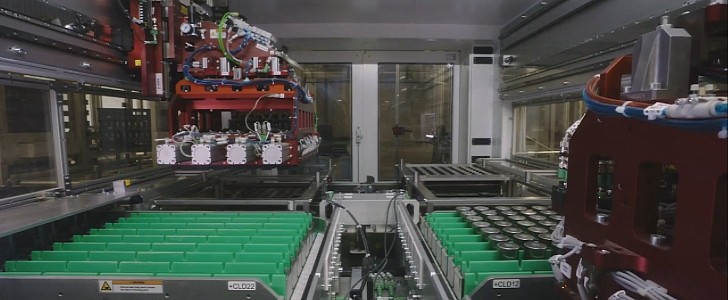Tesla touted their 4680 battery cells are a big step forward. Yet, the limited production keeps Tesla projects like the Cybertruck and Semi from taking off. A recent video shared on the Tesla website shows robots building structural battery packs, presumably at Giga Austin, and the images are mesmerizing.
Tesla introduced the 4680 cells two years ago during the Battery Day event, boasting about how they will change the EV future. The Cybertruck and the Semi were essentially tied to the 4680 cell production, a move that proved less smart. Tesla soon discovered that producing the 4680 cells wasn’t straightforward, which caused both projects to be delayed.
The bigger cells allowed for building a “structural battery pack” to support other vehicle components. They can also reduce the size of the battery manufacturing line by half compared to the 2170 cells. Other benefits include a bigger energy density and power than the existing cells, although this has been disputed by battery experts.
There isn’t much information about the 4680 cells, and that’s why a video posted by Tesla on its media webpage garnered the interest of the EV community. Less than a minute long, the video is nevertheless mesmerizing. Marmann doesn’t say where the video was shot. Still, being in the “Cyber Rodeo videos” category on Tesla’s website, we assume it’s Texas.
Tesla started producing Model Y using the new cells at Giga Austin, and the first cars are already in their owners’ hands. We’ve seen the first range and charging tests, showing promising characteristics. Although not impressive yet, they will surely improve in future software updates. This is a practice that Tesla had perfected before, not least when they debuted the LFP cells on the Model 3.
The production yields for the 4680 cells are not that high. This is one reason Tesla chose a smaller battery capacity for the Model Y. It allowed for building more cars with limited battery production. Nevertheless, Tesla’s suppliers like Panasonic and LGES announced plans to produce their own 4680 cells, so the production problem will ease.
The bigger cells allowed for building a “structural battery pack” to support other vehicle components. They can also reduce the size of the battery manufacturing line by half compared to the 2170 cells. Other benefits include a bigger energy density and power than the existing cells, although this has been disputed by battery experts.
There isn’t much information about the 4680 cells, and that’s why a video posted by Tesla on its media webpage garnered the interest of the EV community. Less than a minute long, the video is nevertheless mesmerizing. Marmann doesn’t say where the video was shot. Still, being in the “Cyber Rodeo videos” category on Tesla’s website, we assume it’s Texas.
Tesla started producing Model Y using the new cells at Giga Austin, and the first cars are already in their owners’ hands. We’ve seen the first range and charging tests, showing promising characteristics. Although not impressive yet, they will surely improve in future software updates. This is a practice that Tesla had perfected before, not least when they debuted the LFP cells on the Model 3.
The production yields for the 4680 cells are not that high. This is one reason Tesla chose a smaller battery capacity for the Model Y. It allowed for building more cars with limited battery production. Nevertheless, Tesla’s suppliers like Panasonic and LGES announced plans to produce their own 4680 cells, so the production problem will ease.








